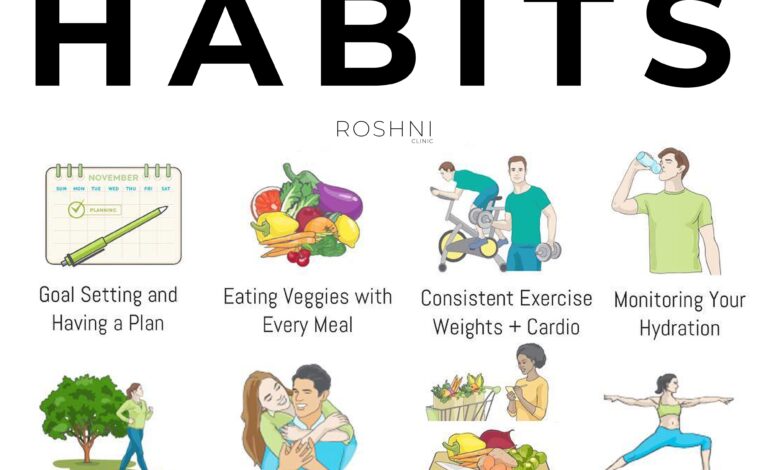Lifestyle & Habit Hacks

Crafting a Better You: Understanding Lifestyle and Habits
We often hear the terms “lifestyle” and “habits” thrown around, but do we truly understand their power and how they intertwine to shape our lives? This post will delve deep into both concepts – exploring what they are, why they matter so much, and most importantly, *how* you can consciously cultivate a lifestyle and habits that lead to greater well-being, success, and fulfillment.
What Exactly is Lifestyle? More Than Just What You Do
Lifestyle encompasses the way you live – your daily routines, choices, values, and priorities. It’s not simply *what* you do, but *how* you do it, and the underlying motivations behind those actions. Think of it as the overall framework within which your habits operate.
Your lifestyle isn’t just about your job or where you live; it includes a vast array of factors: your diet, exercise routine, social connections, how you spend your leisure time, your financial management, your exposure to nature, and even your relationship with technology. It’s the sum total of these choices that paints a picture of your life.
Why is Lifestyle Important? A positive lifestyle contributes significantly to both physical and mental health. Conversely, a negative or unbalanced lifestyle can lead to stress, burnout, chronic illnesses, and a general feeling of dissatisfaction. A well-crafted lifestyle aligns with your values and goals, creating a sense of purpose and direction.
Habits: The Building Blocks of Your Lifestyle
Now let’s move on to habits. Habits are the automatic behaviors we perform regularly, often without conscious thought. They’re ingrained patterns that our brain uses to conserve energy – once a behavior becomes habitual, it requires less mental effort.

The Habit Loop: Cue, Routine, Reward Charles Duhigg’s book, *The Power of Habit*, brilliantly explains the habit loop. It consists of three components:
- Cue: A trigger that initiates a behavior (e.g., seeing your phone on your nightstand).
- Routine: The actual behavior itself (e.g., scrolling through social media).
- Reward: The positive outcome that reinforces the habit (e.g., temporary distraction, feeling connected).
Understanding this loop is crucial for both breaking bad habits and forming new ones.
The Intertwined Relationship: Lifestyle & Habits Working Together
Lifestyle and habits are not separate entities; they’re deeply interconnected. Your lifestyle *shapes* the types of habits you develop, and your habits *reinforce* your lifestyle.
For example, someone with a health-conscious lifestyle might have habits like regularly exercising, eating nutritious meals, and getting enough sleep. Conversely, someone with a sedentary lifestyle may have habits like watching excessive television or frequently snacking on unhealthy foods.
Crafting Your Ideal Lifestyle: A Practical Guide
So, how do you intentionally craft a lifestyle that supports your goals and promotes well-being? Here’s a step-by-step guide:
1. Self-Reflection & Goal Setting
Start with honest self-reflection. What are your values? What truly matters to you? What kind of life do you want to live? Define clear, specific goals in different areas: health, career, relationships, finances, personal growth.
2. Identify Current Habits – The Good, the Bad, and the Neutral
Take a thorough inventory of your current habits. Which ones are serving you well? Which ones are holding you back? Be honest with yourself; this is about creating positive change.
3. Focus on Small Changes: The Power of Micro-Habits
Don’t try to overhaul everything at once! Start small by focusing on one or two habits at a time. Micro-habits are tiny, almost ridiculously easy actions that you can consistently perform. For example, instead of aiming for an hour at the gym, start with 10 minutes.
4. Leverage the Habit Loop: Breaking Bad Habits & Building Good Ones
Breaking a Bad Habit: Identify the cue and reward associated with the habit you want to break. Can you change the cue (e.g., put your phone in another room)? Can you find an alternative, healthier reward that satisfies the same need (e.g., instead of scrolling social media when bored, read a book)?
Building a Good Habit: Design your environment to make it easy to perform the desired behavior. Attach the new habit to an existing one (habit stacking). For example, “After I brush my teeth, I will meditate for 5 minutes.” Reward yourself immediately after performing the new habit – even something small like acknowledging your accomplishment.
5. Consistency is Key: Track Your Progress
Use a habit tracker—whether it’s a simple notebook, a spreadsheet, or a mobile app—to monitor your progress and stay accountable. Seeing your consistency in black and white can be incredibly motivating.
6. Be Patient & Kind to Yourself
Changing habits takes time and effort. There will be setbacks. Don’t beat yourself up over them; simply acknowledge what happened, learn from it, and get back on track.
Specific Lifestyle Areas to Consider
Let’s look at some specific areas where you can apply these principles:
- Health & Fitness: Regular exercise, healthy eating, sufficient sleep, stress management.
- Financial Health: Budgeting, saving, investing, debt reduction.
- Relationships: Nurturing connections with loved ones, setting boundaries, practicing empathy.
- Career/Purpose: Pursuing meaningful work, developing new skills, contributing to something larger than yourself.
- Learning & Growth: Reading, taking courses, exploring new hobbies, embracing challenges.
Conclusion: A Journey of Continuous Improvement
Creating a fulfilling lifestyle and cultivating positive habits is not a destination; it’s an ongoing journey of continuous improvement. By understanding the interplay between lifestyle and habits, and by applying these practical strategies, you can empower yourself to live a more meaningful, healthy, and successful life. Start small, be patient with yourself, and celebrate your progress along the way! You’ve got this!



